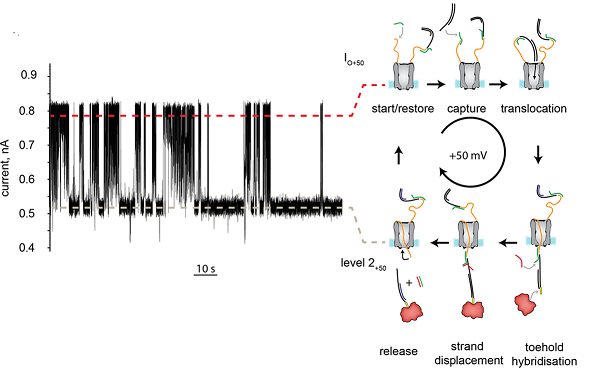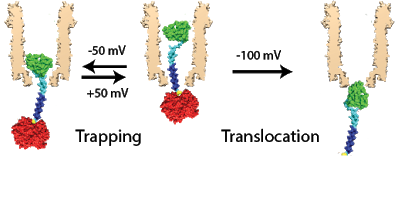Nanopore Machines
Life at the nanoscale is full of surprises. As our understanding of the molecular world evolves, a great challenge is to synthesize and assemble systems that are capable of performing work or completing sophisticated tasks at the molecular scale. Commonly referred to as molecular machines or nanomachnes, these dynamic systems are designed to respond to a variety of external stimuli.
Biological nanopores are ideal building materials in nanotechnology because they have a robust and well-defined structure that self-assemble on biological membranes in a controllable manner. The aim of this research is to design and assemble artificial machine that are able to perform work, selectively transport a cargo or undergo directional motion.
A Nanopore Pump

Protein Rotaxane
We created a protein interlocked system in which protein rotaxane in which a polypeptide thread is encircled by a Cytolysin A (ClyA) nanopore and capped by two protein stoppers. The rotaxane could be switched between two states. At low potential (<-50 mV) the rotaxane is assembled, and at high potentials (-100 mV) the rotaxane is disassembled. This system might find applications in nanoscale memory systems or single-molecule sensors.

Publications
Biesemans A, Soskine M, Maglia G. A protein rotaxane controls the translocation of proteins across a ClyA nanopore. Nano Lett. Aug 5. 9;15(9):6076-81 (2015). DOI: 10.1021/acs.nanolett.5b02309Franceschini, L., Soskine, M, Biesemans, A, and Maglia, G. A nanopore machine promotes the vectorial transport of DNA across membranes. Nature Commun(2013). DOI: 10.1038/ncomms3415
-In the news: DeStandaard, DeRedactie, Knack
-Highlight in Scicasts, Science daily, Nanowerk, PhysOrg, UniverCellmarket, NewsMedical
Further readings
Controlling Motion at the Nanoscale: Rise of the Molecular Machines (2015)
Man-made molecular machines: membrane bound (2016)
| Last modified: | 10 January 2020 11.11 a.m. |
